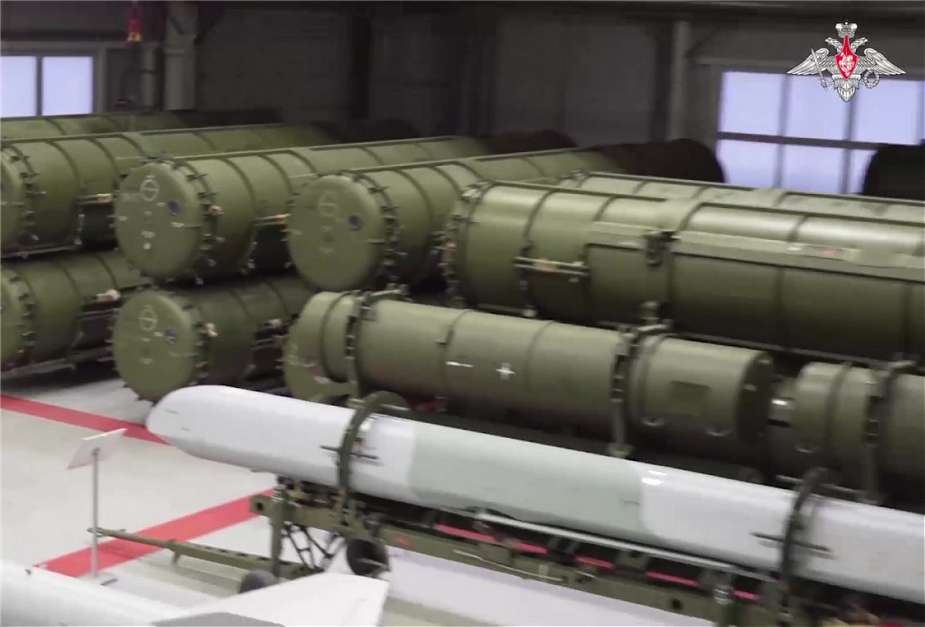Breaking news
British MoD Intel Reports Economic Sanctions Severely Impact Russian Missile Production.
Citing information published by the British Ministry of Defense (MoD) Intelligence Services on April 9, 2024, economic sanctions imposed on Russia in the aftermath of its invasion of Ukraine in February 2022 appear to be significantly affecting the country's defense industry capabilities. Among the most striking implications is the potential difficulty Russia faces in manufacturing the latest generation of its cruise missiles, notably the Kh-101 (NATO reporting name AS-23A Kodiak), a cornerstone of its long-range precision strike arsenal.
Follow Army Recognition on Google News at this link

In January 2024, Russian Minister of Defense Sergei Shoihu visited the production line of the Kh-101 missiles in the Raduga MKB factory. (Picture source Russian MoD)
Open-source photographs dated March 31, 2024, depicting remnants of missile debris in a field within Saratov Oblast, situated in southern Russia. Initial assumptions suggested the wreckage could belong to a Ukrainian uncrewed aerial vehicle; however, further inspection has led intelligence analysts to conclude with high confidence that the debris is from a Russian AS-23a KODIAK (Kh-101) air-launched cruise missile.
The incident is highly likely the result of a malfunctioning KODIAK missile, intended for targets in Ukraine but instead crashing within Russian territory earlier the same day. Saratov Oblast serves as a critical point for Russian Long-Range Aviation bomber operations and is the location of Engels Airfield, which hosts several bombers capable of launching such missiles.
The Kh-101 (AS-23a KODIAK) is at the forefront of Russia's strategic arsenal, boasting an operational range of approximately 4,000 kilometers. It has been frequently deployed against Ukraine, targeting, among other objectives, the country's energy infrastructure. The malfunction of such a high-profile missile, coupled with the implications of production issues potentially induced by international sanctions and the haste to meet the operational demands of the ongoing conflict, points to a notable degradation in the quality and reliability of Russia's military hardware production capabilities.
This incident not only highlights the tangible impacts of economic sanctions on the Russian defense industry but also raises questions about the effectiveness and reliability of its military assets amidst the prolonged conflict in Ukraine. The British MoD's revelations underscore the broader strategic ramifications of international sanctions and their role in shaping military outcomes on the battlefield.
The Kh-101 (NATO code-named AS-23a KODIAK) is a strategic air-to-ground cruise missile developed by Russia, known for its long range and capacity to carry both conventional and thermonuclear warheads. With a length of 7.45 meters and a wingspan of 3 meters, the missile can weigh up to 2,400 kg and carry a warhead weighing 400 kg. It's designed to reduce radar visibility and can reach a maximum speed of 900 km/h, boasting a flight range of up to 5,500 km. The Kh-101 utilizes an inertial guidance system, satellite navigation through the GLONASS system, and terrain comparison guidance for navigation, making it capable of striking targets with high precision across the entire territory of Ukraine.
Recent attacks using the Kh-101 against Ukraine have showcased its strategic importance in Russia's military arsenal. These missiles have been employed in various high-profile strikes on Ukraine's critical infrastructure and military targets. The Kh-101's combination of long range, precision, and reduced radar visibility makes it a challenging target for air defenses. Despite this, Ukraine's air defense has been notably successful in intercepting these missiles, even before the arrival of advanced Western systems like the Patriot missile defense system.
Russian forces have used Kh-101 missiles for a range of targets, from airfields to critical infrastructure, demonstrating its role as a key strategic weapon. The missile's development emphasized stealth features, including a reduced radar cross-section and the capacity for carrying large payloads over long distances. Notably, it can be launched from strategic bombers like the Tu-95MS and Tu-160, increasing its strategic reach and flexibility in deployment.
Ukrainian defenses have adapted to counter the Kh-101 threat, successfully intercepting many missiles through advanced air defense systems and even portable anti-aircraft missile systems (MANPADS). Despite attempts by Russia to upgrade the Kh-101's capabilities, including the use of radar and heat traps to evade air defenses, Ukrainian forces have continued to demonstrate a high degree of resilience and effectiveness in neutralizing these threats.
Defense News April 2024

























